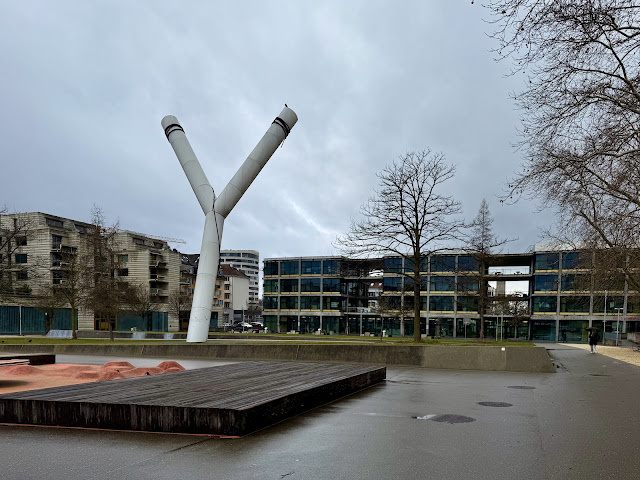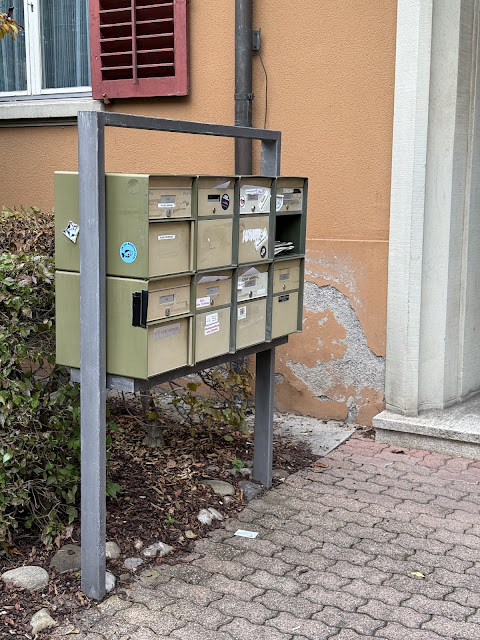I'm also tying this post into the “Blogging from A to Z” challenge — and today’s letter is Y.
Say no more!
The 15-meter (50-foot) high Y by artist Sislej Xhafa stands in a park in Zurich-West, near Hardbrücke and Viadukt Markthalle.
Due to its ambiguity, it has sparked plenty of debate. In English, Y is pronounced like "why," prompting philosophical reflection. Some also see the shape of a slingshot, symbolizing resistance — a nod to the biblical story of David and Goliath. Last but not least, the giant swing attached to the sculpture is a hit among neighborhood kids. At dusk and night, the Y lights up whenever someone sits on the swing.
Sislej Xhafa, born in Peja (Kosovo) in 1970, now lives and works in New York. His installations, objects, and performances often explore themes like authoritarianism, migration, and illegality — in ways that are both complex and unflinching.
Unfortunately, on this dull and drizzly day, I couldn’t see the Y light up. The swing rope hadn’t yet been reinstalled after winter. Here's some drone footage I found on YouTube:
Dystopian Block Housing
While brainstorming for this challenge, it quickly dawned on me: I might struggle to find a truly dystopian block housing complex in Zurich.
This is the "best" example I found, right around the corner from the Y sculpture.
Honestly? I like to think these apartments are still in better shape than many Manhattan studios. As far as I know, Swiss apartments don’t typically have rat infestations.
And if shiny Mercedes are parked on the street next to such buildings, the residents can't be doing too badly. Their priorities then lie with their cars and not with the quality of their homes.
In Switzerland, the housing situation varies significantly between well-maintained residential areas and spots that are considered “Schandflecken” — literally, "places of embarrassment."
Regular housing usually means carefully maintained buildings, a strong sense of community, and a high quality of life. However, tucked away in certain urban areas, there are neglected buildings, often owned by absentee landlords who refuse to invest in proper upkeep.
As I stood in front of the slightly rusty minivan tucked between apartment blocks, I couldn't help but wonder: is this somebody’s "apartment"? Technically, living in your car in Switzerland isn’t outright illegal, and maybe you could manage for a week or two, moving from one neighborhood to the next each night, as long as you had enough gas and coins for parking meters. But sooner or later, this way of living would become unsustainable.
If you can't make rent anymore and living out of a van isn’t a long-term solution, Switzerland does offer emergency shelters ("Notschlafstellen"). However, these are few and come with strict regulations: pets are not allowed, substance use is forbidden, and there are curfews and mandatory check-in times. Spending the night in public isn't a real option either . As you know, Zurich’s station closes for a few hours overnight, and security will ask you to leave.
That said, Switzerland’s social system is built to ensure that, in theory, nobody is left behind. If you lose your job, you’re typically entitled to unemployment benefits for up to two years, depending on your previous work record. After that, you can apply for social welfare ("Sozialhilfe"), which provides basic financial support, housing, health care, essential furniture — and yes, even a television to help maintain a minimum standard of living.
Still, the system isn't perfect: navigating bureaucracy, deadlines, and paperwork can be overwhelming, especially when you're already struggling.
In my own beautiful middle-class village, one such family — originally from the Balkans — lives in a dilapidated apartment fitting this description. The father works in construction, and the mother in a fast food job. Their son, once a classmate of my son, has faced many struggles. Despite receiving ample support from the school system — special education programs, daycare subsidies, and exemptions — a lack of motivation and difficult behavior led him to miss out on many opportunities.
Language barriers may have contributed to the parents' hesitation to attend school meetings or events, missing valuable chances to connect, network, and better understand the Swiss education system.
Over the years, the boy has grown increasingly isolated, both academically and socially. I still hold hope that as he matures, he might realize that without his own effort, his future could mirror his parents’.
While homelessness and poverty paints a harsh picture of urban life, Zurich also has its share of unexpected charm. One example is the Sihl-Ghüür, a sculpture that adds a touch of whimsy and creativity to the city, reminding us that even in challenging places, there’s room for art that lightens the mood.
This one is hard to translate. "Sihl" refers to single-syllable river that flows through Zurich, and "(Un-)Ghüür" is Swiss German for a beast or monster. So, Sihl-Ghüür means something like "the beast of the Sihl" — though this beast looks much more friendly than fearsome. It reminds me of Falkor, the luckdragon from The NeverEnding Story.
Interestingly, the Sihl-Ghüür is less a classic statue and more of an installation. Parts of the beast’s massive tail periodically emerge from the ground throughout the square.
The Sihl-Ghüür was created by the sculptor Peter Meister and is a staggering 100 meters long. That's 100 yards! The actual visible sculpture measures just 4.5 meters; the remaining 95.5 meters are the beast’s tail, hidden underground.
Every now and then, the tail surfaces — marked by a block of white marble.
This makes the Sihl-Ghüür the longest sculpture in Zurich.
Worldwide, it doesn't quite top the list, Malaysia’s Fortune Dragon tunnel, for example, stretches an impressive 115 meters, making it even longer. Still, the Sihl-Ghüür holds its own with a creative concept that playfully weaves through the cityscape.
Even though Zurich's reputation for wealth and beauty made it a challenge to find anything resembling "dystopian block housing," the search led me to discover new sides of the city — from hidden social struggles to playful, thought-provoking sculptures like the giant Y and the whimsical Sihl-Ghüür. Sometimes, following a random letter prompt leads you to unexpected stories and places you might have otherwise overlooked.
Have you ever gone on a themed walk or challenge (like following a letter, color, or word prompt) and discovered something surprising about a place? I'd love to hear your story!











Both those sculptures are neat. I especially love the friendly monster who is partly underground. It's good to hear that the system in Switzerland makes an effort to leave no one behind.
ReplyDeleteI love how you took us from deep reflections on the Y sculpture all the way to a giant friendly tail popping out of the pavement—Zurich really knows how to keep things interesting. Also, now I kinda want to meet the Sihl-Ghüür and ask it for life advice.
ReplyDeleteI love when cities invest in public art. It creates community. That dragon installation is remarkable.
ReplyDeleteLove this post, Tamara. Very clever finding your Y. Thanks for guiding us through the poorer section of Zurich. It's good to know a little of the social system.
ReplyDeleteTamara, how good to hear Zurich tries to take care of the less well-off. Sorry about the unmotivated young man you mention--we really need to take life by the horns and each create our own lifestyle. About the Sihl-Ghuur-- as I was scrolling down my screen, and it came into view, at first I thought it might be a snow sculpture. Or an imitation snow sculpture. Thanks so much for sharing it! As to the giant Y, its real size can be seen when watching that drone video, seeing the tiny form of a human walking by below. Thanks for another super post!
ReplyDelete